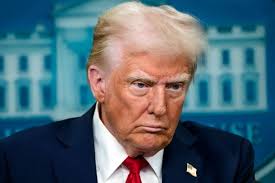Global trade upended as Trump’s new tariffs take effect

U.S. stock futures and Asian equity markets dropped and a bond selloff accelerated as President Trump’s reciprocal tariffs on nearly 100 nations took effect, including a 104% tariff on Chinese imports.
Contracts tied to the S&P 500, Dow industrials and Nasdaq-100 indexes fell between 1% and 1.5%. Japan’s Nikkei Stock Average fell more than 3%. A selloff in longer-term Treasurys picked up momentum, with the yield on the benchmark 10-year note rising to 4.470%, a sign that almost no asset is safe.
Trump defended the tariffs at a Tuesday dinner with House Republicans and said levies on pharmaceutical products made abroad will be announced “very shortly.”US stocks ended lower Tuesday, capping a volatile session that began with hopes of newfound clarity on the president’s tariff policies.
The Dow industrials rose 1,461 points early on, reflecting investors’ faith that the administration may deliver on talk of potential trade deals. They closed down 0.8%, or 320 points, at a 52-week low.
President Trump had earlier announced his latest — and most sweeping — round of tariffs on April 2, which he dubbed “Liberation Day,” as part of his “reciprocal” trade plan. In a speech claiming that other countries had “ripped off” the US for years, Trump declared that the US would now tax nearly all of America’s trading partners at a minimum of 10% — and impose steeper rates for countries that he says run trade surpluses with the US.
The 10% baseline already went into effect Saturday. And when the clock struck at midnight, the higher import tax rates on dozens of countries and territories took hold.
The steeper levies run as high as 50%. Economists warn that the levies will raise prices for goods consumers buy each day — particularly as these new tariffs build on some of previous trade measures. Trump last week announced a tariff of 34% on China, for example, which would come on top of 20% levies he imposed on the country earlier this year.
Trump then added on another 50% levy on Chinese goods in response to Beijing’s recently-promised retaliation. That took the combined total to 104% against China.White House press secretary Karoline Leavitt said at a Tuesday briefing that Trump had not been considering an extension or delay for coming rate increases.
Stocks and the US Dollar have already been falling in response to the threats and early implementation of the tariffs, and it is possible they will fall further. But as it has been, the Trump administration is resolute in seeing this through, even if it causes short term pain.
Global trade will almost surely never go completely back to what it was before Mr Trump announced his tariffs. How it will go will be determined by how other countries respond.


